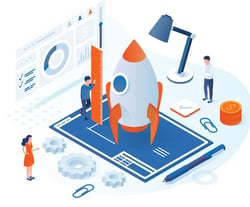 In the product development world, different companies use various methodologies to plan, build, and launch their product lines. Some continue to use the traditional stage-gate methods of making and testing complete prototypes over several years before launching to the market. These companies typically have large-scale, complex physical products such as vehicles, machinery, or massive software programs.
In the product development world, different companies use various methodologies to plan, build, and launch their product lines. Some continue to use the traditional stage-gate methods of making and testing complete prototypes over several years before launching to the market. These companies typically have large-scale, complex physical products such as vehicles, machinery, or massive software programs.
Others are using newer agile methods to create and test more frequently to launch more often. These companies produce software and digital products that align with relatively short timelines. And others yet are using a hybrid strategy that falls somewhere in the middle, usually because their product has hardware components and software components. While each methodology has strong supporters who swear their method is the best, the reality is your approach depends on the products you're creating.
Bringing Software and Hardware Together: Focusing on the Cadence
 When multiple teams are using different approaches, there needs to be an emphasis on aligning their cadence. As product managers, you need to be able to set up phases on your product roadmap so everyone knows the following:
When multiple teams are using different approaches, there needs to be an emphasis on aligning their cadence. As product managers, you need to be able to set up phases on your product roadmap so everyone knows the following:
- What are the deadlines for each stage?
- When will a component be ready?
- When will a prototype be tested?
The Nature of Hardware Lead Times
Everything about hardware takes longer than it does with software. More time and capital is involved in its production, from sourcing materials to negotiating with suppliers to shipping components to the labor and machinery required to assemble it. With all these essential steps, the cycle cannot be shortened.
Because of the time and investment involved in assembling the hardware, there is less room for error. Detailed planning is vital for success. Planning the product and testing the physical prototype can take a lot of time, which is where 3D simulations and digital testing can help, depending on the product. Even with this option, manufacturers of physical products tend to lean on traditional stage-gate methods to approve their designs and guide their product roadmaps. Partly because of the investment involved and partly conditions in the real world cannot always be completely replicated in lab or simulated conditions. The thought of adopting agile practices of rapid testing and iterating may make these product managers cringe.
The Nature of Software Lead Times
Software needs far less time than hardware to develop and piece together. Design and development teams working on software also have the advantage of prototyping their product in small chunks, then test and fix any problems before moving on to the next phase. Lead times are much shorter in a digital space that doesn't require materials or supply shipments. For most software product teams, using agile methods to rapidly iterate, test, and fix their design is the only strategy to use.
The Art of Balancing Both
Managing different teams using stage-gate and agile is both an art and a challenge because it can lead to resistance when it comes to cooperation. The key is to find a way to make each team's cadence sync and avoid resistance. Here are two examples of how both methods can work together.
Example One: Lining Up the Milestones
A product with both a software component and a hardware component can find alignment by lining up the software team's agile schedule with the appropriate stage of the hardware process. Knowing the sequence of the stage-gate milestones helps the software teams ensure they are ready. Coordinating the short lead times of the software with the long lead times of the hardware avoids having either team waiting idle while the other team is finishing their part. Product managers can communicate these deadlines using the product roadmap, where all teams can see the milestones and stay aware of any possible delays.
Example Two: Finding a Middle Route
With large, complex software products, each team working on a portion of the software may use a hybrid version of stage-gate and agile. In this scenario, all teams need to know the clear deadlines for each phase of the project, so they can bring their components together, but there is more flexibility as offered by Agile. This hybrid model allows teams to work on parts simultaneously while bringing them together on set intervals or check points before the hard deadline to test the final prototype and then the final product. In this model, each team is technically adopting agile practices, but the overarching strategy is a version of stage-gate because the details are planned out in advance.
The Hesitation to Embrace the Hybrid Model
 We understand how larger companies with complex products are hesitant to let go of the stage-gate model. With long lead times to negotiate supply chains, retrofit a factory, design a complex system, and many parts coming together, all against market needs and competitive landscape, it is clear that delays or rework can cause extensive cost. They need clear deadlines, detailed advance planning, and long-term launch dates for delivering their product to the market. The idea of switching to true Agile, which gets rid of deadlines and relies on fluid development, testing, and launching as a product is ready, doesn't seem realistic in the outset. Switching to Agile isn't possible without the proper systems in place.
We understand how larger companies with complex products are hesitant to let go of the stage-gate model. With long lead times to negotiate supply chains, retrofit a factory, design a complex system, and many parts coming together, all against market needs and competitive landscape, it is clear that delays or rework can cause extensive cost. They need clear deadlines, detailed advance planning, and long-term launch dates for delivering their product to the market. The idea of switching to true Agile, which gets rid of deadlines and relies on fluid development, testing, and launching as a product is ready, doesn't seem realistic in the outset. Switching to Agile isn't possible without the proper systems in place.
However, there is a middle ground to start with. As long as product management teams use their roadmaps to keep their teams informed and aligned to overall phase deadlines, any complex product can use a hybrid method, keeping both teams happy and delivering a product on schedule.
Ignoring the Noise
Each product development approach has strong supporters that will proclaim their methodology is the only one that works. While it's wise to see what other companies are doing and to learn from their wins and mistakes, it's also important to ignore the strongest opinions and create a method that works best for your company, especially if a hybrid approach seems to be the best fit at this stage of your organization's journey. The right strategy is the one that keeps your teams aligned and delivers high-performing products to your market. The goal is not to implement a framework, the goal is to improve the ways of working.
A little about Gocious Product Roadmap Management for Hybrid Models
The key to success, no matter what methodology you use, is having adaptable roadmaps for your products that everyone can use to stay informed. Gocious Product Roadmap Management software is designed to make managing all teams effective and efficient with one source of truth. Book your demo to see how Gocious can help you sync your teams.


